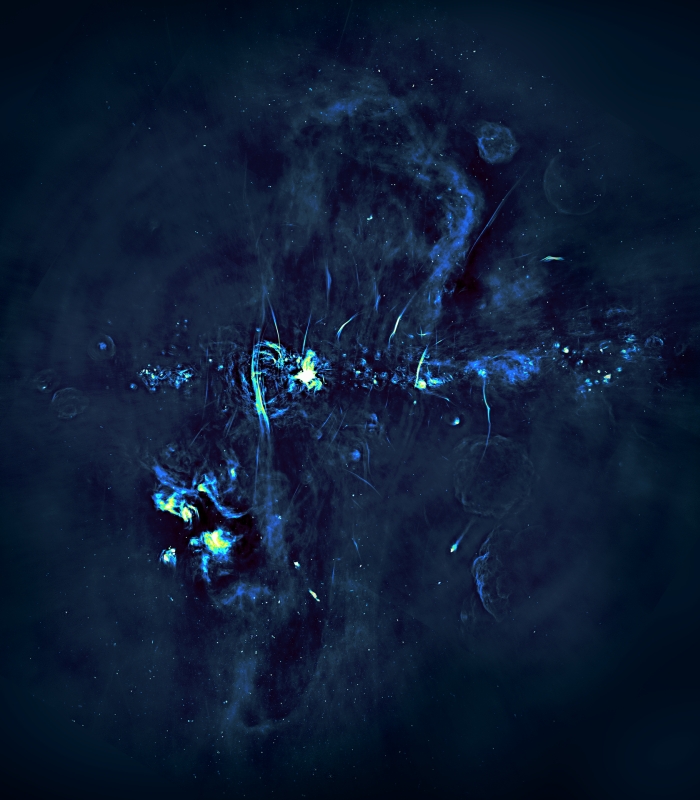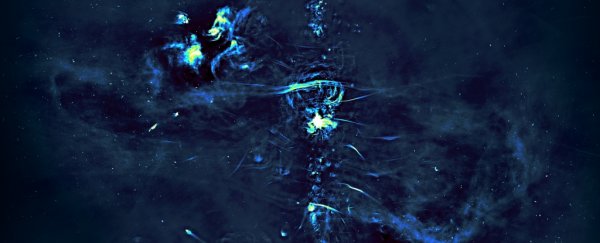The region at the centre of our galaxy is still full of mysteries, but astronomers have just found a clue to its past: Huge, radio-emitting bubbles, extending 700 light-years either side of the galactic plane.
They could be, the researchers believe, the result of a huge eruption from our galaxy's supermassive black hole, Sagittarius A*. Millions of years ago that eruption would have punched into the interstellar medium in opposite directions from the supermassive black hole.
If 'galactic bubbles' sound a bit familiar to you, we need to clarify that these are not the huge gamma-ray bubbles discovered by the Fermi Gamma-ray Space Telescope in 2010, spanning above and below the galactic plane for a total distance of 50,000 light-years.
These latest bubbles are something new, and astronomers haven't seen them before. But they are amongst the biggest structures at the centre of our galaxy, and they reveal new information about the dynamics of our galactic nucleus.
"The centre of our galaxy is relatively calm when compared to other galaxies with very active central black holes," explained astrophysicist Ian Heywood of the University of Oxford.
"Even so, the Milky Way's central black hole can become uncharacteristically active, flaring up as it periodically devours massive clumps of dust and gas. It's possible that one such feeding frenzy triggered powerful outbursts that inflated this previously unseen feature."
 (SARAO/Oxford)
(SARAO/Oxford)
Hints of the structures first emerged in the 1980s, when astronomer and physicist Farhad Yusef-Zadeh of Northwestern University and colleagues discovered something strange in the galactic centre: long, thin, highly organised and highly magnetised filaments of gas, tens of light-years long and just one light-year wide, emitting synchrotron radio waves.
These strange structures hadn't been observed anywhere else, and their origin remained a mystery for decades.
But something changed. The South African Radio Astronomy Observatory's MeerKAT telescope was built, consisting of 64 interconnected radio antennae that offer "unprecedented" sensitivity in radio wavelengths, perfectly positioned in the Southern Hemisphere to take deep images of the galactic centre.
The international team turned the telescope on the heart of the Milky Way. And, for the first time, they were able to see the structures of these radio bubbles, faint but detectable, amidst the incredibly radio-bright glare in the region.
The event that caused it could be responsible for accelerating the electrons that resulted in the synchrotron emission observed in the filaments in the galactic centre.
"The radio bubbles discovered with MeerKAT now shed light on the origin of the filaments," Yusef-Zadeh said. "Almost all of the more than 100 filaments are confined by the radio bubbles."
The entire hourglass-shaped structure extends 1,400 light-years, and is unusually symmetrical. This symmetry provides some clues as to what created them; the size, constrained by the speed of light, puts an upper limit of a few million years on their age.
 (Heywood et al., Nature, 2019)
(Heywood et al., Nature, 2019)
"The shape and symmetry of what we have observed strongly suggests that a staggeringly powerful event happened a few million years ago very near our galaxy's central black hole," said astronomer William Cotton of the National Radio Astronomy Observatory.
"This eruption was possibly triggered by vast amounts of interstellar gas falling in on the black hole, or a massive burst of star formation which sent shockwaves careening through the galactic centre.
"In effect, this inflated energetic bubbles in the hot, ionised gas near the galactic centre, energising it and generating radio waves which we could eventually detect here on Earth."
Although the radio bubbles are smaller and less energetic than the Fermi bubbles - 7 x 1052 ergs compared to 1056 ergs for the Fermi bubbles - it's possible that similar events created both sets of bubbles, the researchers said.
It's even possible that both sets of bubbles were created by a linked series of events. Perhaps future observations across a range of wavelengths can tell us more.
The research has been published in Nature.
